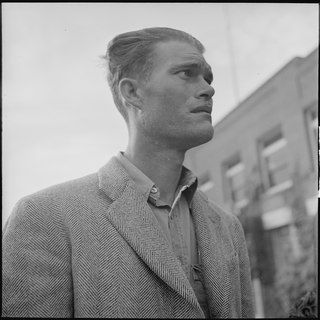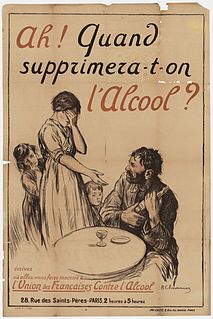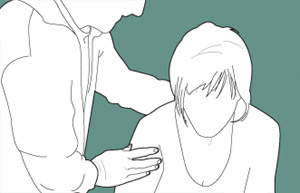Related Research Articles

Anxiety is an emotion characterized by an unpleasant state of inner turmoil and includes subjectively unpleasant feelings of dread over anticipated events. It is often accompanied by nervous behavior such as pacing back and forth, somatic complaints, and rumination.

Alcoholism is, broadly, any drinking of alcohol that results in significant mental or physical health problems. Because there is disagreement on the definition of the word alcoholism, it is not a recognized diagnostic entity. Predominant diagnostic classifications are alcohol use disorder (DSM-5) or alcohol dependence (ICD-11); these are defined in their respective sources.

Agoraphobia is a mental and behavioral disorder, specifically an anxiety disorder characterized by symptoms of anxiety in situations where the person perceives their environment to be unsafe with no easy way to escape. These situations can include open spaces, public transit, shopping centers, or simply being outside their home. Being in these situations may result in a panic attack. Those affected will go to great lengths to avoid these situations. In severe cases people may become completely unable to leave their homes.

Fibromyalgia (FM) is a medical condition characterized by chronic widespread pain and a heightened pain response to pressure, temperature, weather, and touch. Other symptoms include tiredness to a degree that normal activities are affected, sleep problems such as nonrestorative sleep and restlessness, and cognitive dysfunctions. Some people also report restless legs syndrome, bowel or bladder problems, numbness and tingling and sensitivity to noise, lights or temperature. Patients with fibromyalgia are more likely to suffer from depression, anxiety and posttraumatic stress disorder.

In psychology, trait theory is an approach to the study of human personality. Trait theorists are primarily interested in the measurement of traits, which can be defined as habitual patterns of behaviour, thought, and emotion. According to this perspective, traits are aspects of personality that are relatively stable over time, differ across individuals, are relatively consistent over situations, and influence behaviour. Traits are in contrast to states, which are more transitory dispositions.
Dissociation, as a concept that has been developed over time, is any of a wide array of experiences, ranging from a mild emotional detachment from the immediate surroundings, to a more severe disconnection from physical and emotional experiences. The major characteristic of all dissociative phenomena involves a detachment from reality, rather than a loss of reality as in psychosis.

Conversion disorder (CD), or functional neurologic symptom disorder, is a diagnostic category used in some psychiatric classification systems. It is sometimes applied to patients who present with neurological symptoms, such as numbness, blindness, paralysis, or fits, which are not consistent with a well-established organic cause, which cause significant distress, and can be traced back to a psychological trigger. It is thought that these symptoms arise in response to stressful situations affecting a patient's mental health or an ongoing mental health condition such as depression. Conversion disorder was retained in DSM-5, but given the subtitle functional neurological symptom disorder. The new criteria cover the same range of symptoms, but remove the requirements for a psychological stressor to be present and for feigning to be disproved. ICD-10 classifies conversion disorder as a dissociative disorder while DSM-IV classifies it as a somatoform disorder.
Manganism or manganese poisoning is a toxic condition resulting from chronic exposure to manganese. It was first identified in 1837 by James Couper.

Obstructive sleep apnea (OSA) is the most common sleep-related breathing disorder and is characterized by recurrent episodes of complete or partial obstruction of the upper airway leading to reduced or absent breathing during sleep. These episodes are termed "apneas" with complete or near-complete cessation of breathing, or "hypopneas" when the reduction in breathing is partial. In either case, a fall in blood oxygen saturation, a disruption in sleep, or both may result. A high frequency of apneas or hypopneas during sleep may interfere with restorative sleep, which – in combination with disturbances in blood oxygenation – is thought to contribute to negative consequences to health and quality of life. The terms obstructive sleep apnea syndrome (OSAS) or obstructive sleep apnea–hypopnea syndrome (OSAHS) may be used to refer to OSA when it is associated with symptoms during the daytime.

Moclobemide is a reversible inhibitor of monoamine oxidase A (RIMA) drug primarily used to treat depression and social anxiety. It is not approved for use in the United States, but is approved in other Western countries such as Canada, the UK and Australia. It is produced by affiliates of the Hoffmann–La Roche pharmaceutical company. Initially, Aurorix was also marketed by Roche in South Africa, but was withdrawn after its patent rights expired and Cipla Medpro's Depnil and Pharma Dynamic's Clorix became available at half the cost.
Robert Leopold Spitzer was a psychiatrist and professor of psychiatry at Columbia University in New York City. He was a major force in the development of the Diagnostic and Statistical Manual of Mental Disorders (DSM).
Post-acute withdrawal syndrome (PAWS) is a hypothesized set of persistent impairments that occur after withdrawal from alcohol, opiates, benzodiazepines, antidepressants, and other substances. Infants born to mothers who used substances of dependence during pregnancy may also experience a post-acute withdrawal syndrome. While post-acute withdrawal syndrome has been reported by those in the recovery community, there have been few scientific studies supporting its existence outside of protracted benzodiazepine withdrawal. Because of this, the disorder is not recognized by the Diagnostic and Statistical Manual of Mental Disorders or major medical associations.

Panic disorder is a mental and behavioral disorder, specifically an anxiety disorder characterized by reoccurring unexpected panic attacks. Panic attacks are sudden periods of intense fear that may include palpitations, sweating, shaking, shortness of breath, numbness, or a feeling that something terrible is going to happen. The maximum degree of symptoms occurs within minutes. There may be ongoing worries about having further attacks and avoidance of places where attacks have occurred in the past.
In personality pathology, dimensional models of personality disorders conceptualize personality disorders as quantitatively rather than qualitatively different from normal personality. They consist of extreme, maladaptive levels of certain personality characteristics. Within the context of personality psychology, a "dimension" refers to a continuum on which an individual can have various levels of a characteristic, in contrast to the dichotomous categorical approach in which an individual does or does not possess a characteristic. According to dimensional models personality disorders are classified according to which characteristics are expressed at which levels. This stands in contrast to the traditional categorical models of classification, which are based on the boolean presence or absence of symptoms and do not take into account levels of expression of a characteristic or the presence of any underlying dimension.

KKS Wiara Lecha or Drużyna Wiary Lecha abbreviated to DWL, is a sports club from Poznań founded by Lech Poznań supporters in 2011 and ran by the former official Lech Poznań supporter group Wiara Lecha. Only active supporters can play in the team and they have to have made a contribution to the supporter scene in order to be admitted to the squad. It has association football, basketball, rugby union and futsal teams.
The Neurotic Personality Questionnaire KON-2006 is a psychometric tool used for diagnosing personality dysfunctions that contribute to the development of neurotic disorders. The use of the questionnaire may facilitate the diagnosis of neurotic disorder, as well as make it easier to differentiate between neurotic and pseudoneurotic syndroms, e.g. reaction to stress. Moreover, the questionnaire enables evaluation of changes occurring in the course of treatment.

Ląd Abbey is a former Cistercian monastery in Ląd, Poland. It currently houses a seminary, the Wyższe Seminarium Duchowne Towarzystwa Salezjańskiego, run by the Salesian order. On 1 July 2009, Ląd Abbey was designated an official Polish Historic Monument.

The Hypomania Checklist (HCL-32) is a questionnaire developed by Dr. Jules Angst to identify hypomanic features in patients with major depressive disorder in order to help recognize bipolar II disorder and other bipolar spectrum disorders when people seek help in primary care and other general medical settings. It asks about 32 behaviors and mental states that are either aspects of hypomania or features associated with mood disorders. It uses short phrases and simple language, making it easy to read. The University of Zurich holds the copyright, and the HCL-32 is available for use at no charge. More recent work has focused on validating translations and testing whether shorter versions still perform well enough to be helpful clinically. Recent meta-analyses find that it is one of the most accurate assessments available for detecting hypomania, doing better than other options at recognizing bipolar II disorder.

The Weinberg Screen Affective Scale (WSAS) is a free scale designed to screen for symptoms of depression in children and young adults ages 5–21. It can be used as an initial treatment scale and can be used to follow up on treatment efficacy. There are 56 self-report questions that screen for symptoms in 10 major categories of depression: dysphoric mood, low self-esteem, agitation, sleep disturbance, change in school performance, diminished socialization, change in attitude towards school, somatic complaints, loss of usual energy, and unusual change in weight and/or appetite. The scale is based on previously proposed criteria for depression in children. A study looking at the agreement between scales for depression diagnosis found 79.4% agreement between the DSM-III and the WSAS in a sample of 107 children.
The 9-question Patient Health Questionnaire (PHQ-9) is a diagnostic tool introduced in 2001 to screen adult patients in a primary care setting for the presence and severity of depression. The PHQ-9 is the self-administered depression scale from the Patient Health Questionnaire (PHQ). The PHQ is part of Pfizer's larger suite of trademarked products, called the Primary Care Evaluation of Mental Disorders (PRIME-MD). The PHQ-9 takes less than 3 minutes to complete and simply scores each of the 9 DSM-IV criteria for depression based on the mood module from the original PRIME-MD. Primary care providers frequently use the PHQ-9 to screen for depression in patients.
References
- 1 2 3 4 5 6 Aleksandrowicz JW., Bierzyński K, Filipiak J, Kowalczyk E, Martyniak J i wsp. Kwestionariusze objawowe "S" i "0" – narzędzie służące do diagnozy i opisu zaburzeń nerwicowych. Psychoter. 1981; 37: 11-28
- 1 2 3 4 5 6 Rewer A. Skale kwestionariusza objawowego "0". Psychiatr. Pol. 2000; 34(6): 931-43
- 1 2 3 4 Aleksandrowicz JW, Sobański JA. Kwestionariusz selekcyjny S-III: narzędzie screeningowe przydatne do wstępnej diagnostyki zaburzeń nerwicowych. Doniesienie z badań pilotowych. XLIII Zjazd Psychiatrów Polskich, Poznań, 23–26 czerwca 2010 r.
- 1 2 3 4 Aleksandrowicz JW, Sobański JA. Kwestionariusz objawowy S-III. Psychiatr. Pol. 2011; 45(4): 515-26
- 1 2 3 Aleksandrowicz JW. Kwestionariusz objawowy "S-II". Psychiatr. Pol. 2000; 34(6)
- ↑ Sobański JA, Klasa K, Simon W, Aleksandrowicz JW, Rutkowski K. Kwalifikacja do psychoterapii i ocena wyników leczenia zaburzeń nerwicowych: kwestionariusze objawowe KO"0", KSIII, OQ-45.2, kwestionariusze osobowości KON-2006 i NEO-PI-R. XLIII Zjazd Psychiatrów Polskich, Poznań, 23–26 czerwca 2010 r.
- ↑ Murzyn A, Sobański JA, Mielimąka M, Rutkowski K. Nasilenie zaburzeń oraz skuteczność psychoterapii pacjentów z doświadczeniem wczesnodziecięcej traumy. XLIII Zjazd Psychiatrów Polskich, Poznań, 23–26 czerwca 2010 r.
- ↑ Murzyn (Białas) A, Mielimąka M, Rutkowski K. Nasilenie zaburzeń oraz skuteczność psychoterapii pacjentów z doświadczeniem wczesnodziecięcej traumy. XLIII Zjazd Psychiatrów Polskich, 23-26 czerwiec 2010, Poznań
- ↑ Aleksandrowicz JW., Hamuda G. Kwestionariusza objawowe w diagnozie i w badaniach epidemiologicznych zaburzeń nerwicowych. Psychiatr. Pol. 1994; 28 (6): 667-76
- ↑ Sobański JA, Klasa K, Rutkowski K, Dembińska E, Müldner-Nieckowski Ł. Kwalifikacja do intensywnej psychoterapii w dziennym oddziale leczenia nerwic. Psychiatria i Psychoterapia. 2011; 7(4): 20-34
- 1 2 Aleksandrowicz JW. Częstość objawów nerwicowych. Psychiatr. Pol. 2000; 34(1): 5-20
- ↑ Derogatis LR, Cleary P. Confirmation of the dimensional structure of the SCL-90: A study in construct validation. J. Clin. Psychol. 1977; 33 (4): 981-89
- ↑ Kiejna A, Kantorska-Janiec M. Epidemiologia zaburzeń psychicznych a nowe narzędzia stosowane w badaniach. Med. Psychiatr. Neurol. 1999: 3(1): 12-18
- ↑ Sobański JA, Cyranka K, Rodziński P, Klasa K, Rutkowski K et al. Czy cechy osobowości i nasilenie objawów nerwicowych wiążą się ze sprawozdawaniem myśli samobójczych u pacjentów dziennego oddziału leczenia zaburzeń nerwicowych? Psychiatr. Pol. 2014 epub ahead of print (31.12.2014) doi: 10.12740/psychiatriapolska.pl/online-first/5